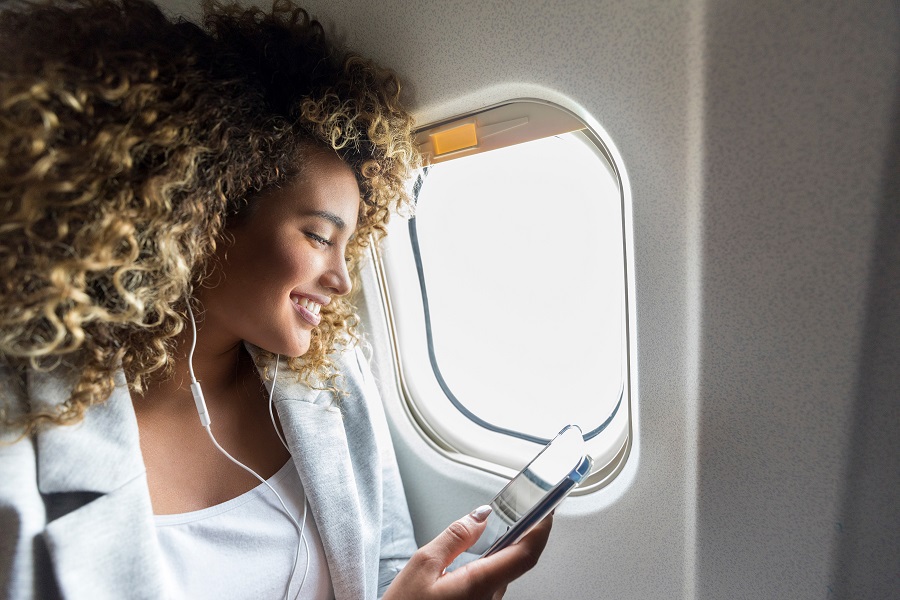With Apple officially launching support for digital ID and mobile driving licenses (mDLs) in the Apple Wallet in Arizona and plans to roll out the support to Connecticut, Iowa, Kentucky, Maryland, Oklahoma, and Utah this year, the future looks bright and digital for a more seamless passenger journey.
The news comes as a welcome step forward in the maturity of digital identity in the air transport industry. It empowers passengers to use their mobile device as their remote control for travel. Adding a driver’s license or state ID to the Apple Wallet can be done in a few simple steps using the smartphone camera and physical ID to ensure that the person adding the identity card to the Wallet is the same person to whom the identity card belongs. The state is responsible for verifying and approving the user’s request to add their driver’s license or state ID to Wallet. Once approved, users will no longer have to show their physical ID or license; the digital version is accepted with the same level of trust as if it were a physical ID.
In a great leap forward for the seamless travel journey, the digital ID will be an available option for TSA PreCheck® travelers and accepted by the Transportation Security Administration (TSA) at checkpoints in approved airport locations, with Phoenix being among the first. At the checkpoint, travelers just tap their iPhone or Apple Watch at the TSA’s Credential Authentication Technology (CAT) reader. Using NFC communication, a secure connection is established between the user device and the CAT reader. The user is provided the opportunity to review what information will be shared with the TSA for the verification process. Users unlock their phone with Face ID or Touch ID to provide consent and without having to hand-over possession of their device. The TSA reviews the information and also captures a photo of the traveler for verification purposes, ensuring the holder of the phone is also the traveler and ID-holder. Next, the CAT system connects to the TSA’s SecureFlight database to confirm flight information, also eliminating the need for travelers to show or scan the boarding pass.
According to Statista, the current number of smartphone users today is 6.648 billion. This figure is up considerably from 2016, when there were only 3.668 billion users, making this an ideal time to introduce more convenient digital identity processes for travel. Giving passengers full control of their identity and digitizing the passenger experience helps simplify the travel experience, boost confidence to fly, and reduces physical touch points when COVID remains a significant travel challenge in many parts of the world.
To travel, a digital form of ID alone is not enough. Travelers must also prove they have a valid boarding pass and might also have to provide proof of health status or other health-related paperwork to authorize right to travel. When digital ID is coupled with biometric-enabled passenger processing and integration with existing airline systems and infrastructure, there is tremendous opportunity to modernize the customer experience.
Today, few US airports have adopted a fully biometric-enabled passenger journey, particularly for domestic travel. Often this has been due to regulatory constraints as much as the lack of a machine-readable and verifiable way to verify a form of ID other than an e-chip passport. Still, examples do exist across the industry, such as San Francisco International Airport and United Airlines’ successful trial of SITA Smart Path to support a low-touch experience and optimize passenger processing, by enabling US domestic travelers to scan their driver’s license as part of the airline check-in process. At bag-drop and boarding, a traveler just takes a quick photo, and their boarding pass information is verified, eliminating the need to fumble around to hand-over possession of an ID or boarding pass for scanning by the agent. Projects such as this continue to show that biometrics will play a crucial role in the airport of the future. Beyond the airport, biometrics can also serve as a convenient and secure approach to auxiliary services like car rental, event entrance or hotel accommodation.
The air transport industry has made excellent progress in digitizing essential processes, such as obtaining a visa, booking travel, and organizing accommodation. The aviation sector has come a long way in transforming outdated paper-based processes into modern digital equivalents. And it will soon be the case – throughout all 27 Member States of the European Union – that the process of verifying a passenger’s identity and ‘stamping’ their passport will become fully digitized and automated.
Since the emergence of the COVID-19 pandemic, we’ve seen an important international initiative underway to help digitalize the verification of health status for travel, thanks to ICAO, in the form of the Digital Travel Credential (DTC). In the medium to long term, the DTC will enable governments to have far greater trust in biometric and biographic data they receive directly from passengers as it will immediately establish that the data is genuine, isn’t forged and hasn’t been tampered with in any way. Using a wallet to identify a document (whether a DTC or mDL) is a positive step forward as it gives the user control and allows all other apps to access that data instead of storing the document in each app which is a closed, proprietary approach.
As encouraging as these milestones are, we must not lose sight of ensuring government authorities receive the information they need when they need it. Indeed, only when they are satisfied with the quality, completeness, and timeliness of data received – particularly for the traveler’s digital identity – can we realistically expect to turn our attention to devising better, faster, more streamlined passenger experiences. And we must ensure new requirements do not add confusion, time, or complexity to the journey.
It is simply not enough for one airport, transport operator, or hotel to make standalone digital options available to a subset of their passengers and guests. Digital Travel must be universal to succeed and ensure operations are demonstrably capable of making travel easier every step of the way. It will enable passengers to have direct control over every aspect of a safe, secure, easy, and trusted process – whenever, wherever, and however they travel.
We expect in the coming years that the development of a universally accepted digital identity will replace the traditional passport. This will allow travel across borders with any airline or airport while ensuring the passenger remains in complete control of their identity while providing actionable, trusted data only to appropriate parties such as border agencies.
The benefits include a reduced arrivals infrastructure, providing new opportunities to increase existing airport throughput by design and not expansion. Ultimately simplifying the passenger journey through digital identity will be a foundation for rebuilding a more resilient and agile air transport industry that entices large volumes of passengers to return to the skies. SITA continues to work with governments, airlines, and airports to develop and deliver the benefits of travel using a permanent digital identity.





 Share
Share







0 Comments